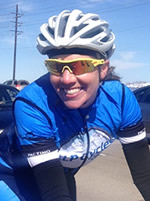While it is impossible to eliminate all the risks associated with riding in the rain, there are tips and techniques that will help keep the rubber on the road.
Here’s just a few:
1. “Pump” Your Brakes
As you approach a stop give your brake lever a couple light pumps. This will squeegee the water from the rim and make the pads more efficient even if they’re still damp. When executing, make sure to use a light touch and start with the rear brake before doing the same with the front. Of course if you have disc brakes you can forego this!
2. Shift Your Weight
If you typically ride in dry conditions, you probably give little thought to your body position when stopping. But in wet conditions it is imperative to shift your weight back to maximize rear wheel traction. As you approach a stop, slide back on your saddle. For emergency stops get out of the saddle and push your hips back over the rear wheel.
3. Pedal While Stopping
If you continue to pedal while braking, your rear wheel will be far less likely to lock up and skid. The pedaling keeps the tire spinning even when significant brake pressure is applied. This might seems awkward the first time you try it, so you might want to practice on dry roads until you get the hang of it.
4. Steer, Don’t Lean
Avoid leaning into corners and focus more on turning the front wheel through the curve. This will keep your bike more upright and result in more downward force on the tires. And of course, take corners a little slower!
5. Brake Before The Turn
Probably the worst thing you can do in wet conditions is brake in a corner. You’ll lose complete control and exponentially increase your chances of going down. Instead, brake early and release before actually making your turn, while also pedaling through the corner. If you truly need to brake in a turn, use only the rear lever—applying pressure evenly and releasing quickly. And don’t stop pedaling.
6. Everything Gets Slippery
Road surfaces are especially slick when it first starts to rain as oil and other gunk is washed up. For a cyclist, this super slick condition will last a whole lot longer than it does for people driving cars. Make sure to watch out for oily looking patches or puddles, as attempting to turn or stop in one could be very hazardous. Similarly, a build up of wet, fallen leaves, steel street plates, wood or metal bridge decking, manhole covers and painted road markings are all going to be things to traverse with caution.
7. Don’t Bomb Through Puddles
When we were kids we loved the rain for the puddles! But, as a cyclist you should always avoid puddles. What might appear to be something fun to splash through could actually be a foot deep pothole or a sewer grate just waiting to grab your front wheel. Stay away from puddles and you’ll significantly reduce your chances of a pinch flat, broken rim or a trip over the handlebars.

(Do we need to say that it’s not a good idea to ride holding an umbrella?)
8. Right Hand On Bars
We’ve mentioned it above: braking when it’s wet should primarily be with your rear brake. You are far less likely to skid out or crash when engaging the rear brake than you are when you utilize your front brake—even if you lock the rear wheel. That means you should always keep your right hand on the bars and ready to brake, and use your left hand to reach for a water bottle or rummage around in a pocket.
Hopefully these tips will help you to stay safe and actually enjoy a ride in the rain.
About the Author
 Tony Kelsey has 20 years marketing experience, previously serving as global vice president of creative for an international, $1B IT solutions consultancy. Although a self-proclaimed “mediocre” racer in high school, his intense passion for cycling and bicycles in general has never waned. Today he is marketing VP at primalblends and frequently writes about cycling as a sport and hobby. @tonykelsey
Tony Kelsey has 20 years marketing experience, previously serving as global vice president of creative for an international, $1B IT solutions consultancy. Although a self-proclaimed “mediocre” racer in high school, his intense passion for cycling and bicycles in general has never waned. Today he is marketing VP at primalblends and frequently writes about cycling as a sport and hobby. @tonykelsey
 Jennifer Sharp, a USA Cycling Level 1 Coach, started racing in 2004 as a means to fulfill her competitive itch. Previously a national level boxer, she grew tired of getting hit in the head and decided to pound the pedals instead. She bought a pink Kona road bike completing several recreational rides and found herself passing as many people as possible. Since then she has multiple podiums at elite track national championships, master track national championship titles and world cup finishes under her belt.
Jennifer Sharp, a USA Cycling Level 1 Coach, started racing in 2004 as a means to fulfill her competitive itch. Previously a national level boxer, she grew tired of getting hit in the head and decided to pound the pedals instead. She bought a pink Kona road bike completing several recreational rides and found herself passing as many people as possible. Since then she has multiple podiums at elite track national championships, master track national championship titles and world cup finishes under her belt.